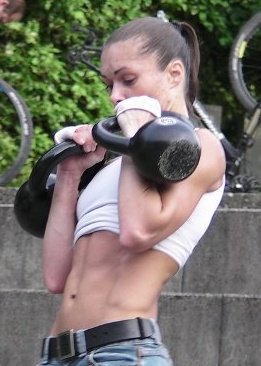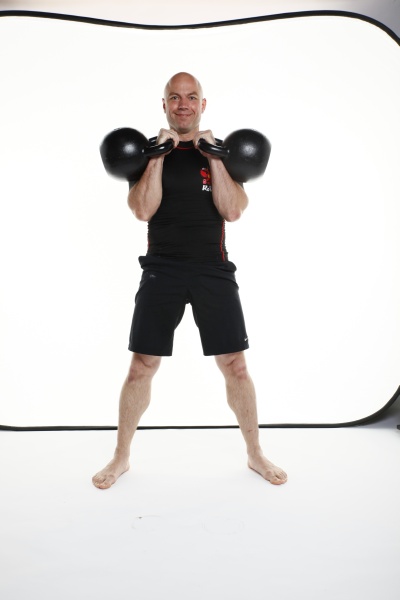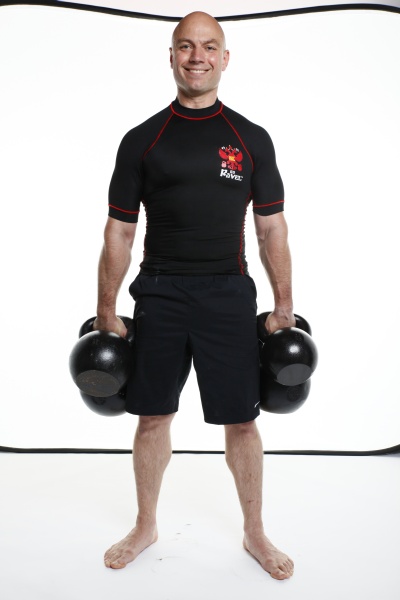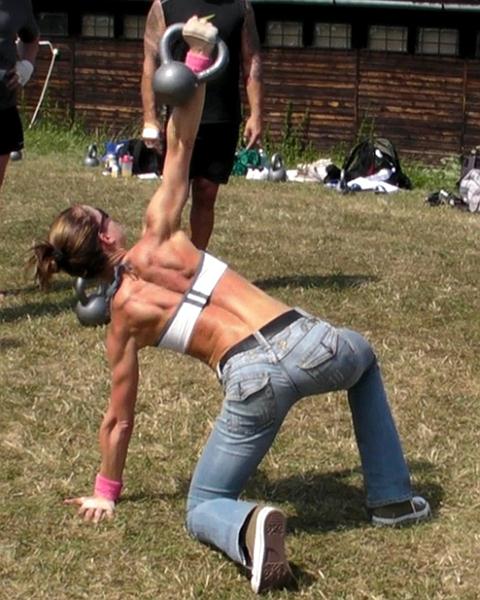Robert Rimoczi: In 2007, someone on my internet forum wrote about the incredible results that could be achieved with kettlebells. I watched several videos and quickly understood some advantages of training with them. My friends are probably still laughing about my first forum comment about kettlebells, it was something like, "That's great, and there's definitely a lot I want to learn, but I think that two 48 kg (the largest Dragon Door kettlebells) are too light for squats..."
I am now incomparably stronger, but squats with two 48 kg kettlebells are still a challenge for me. Back then—even though I was able to back-squat 200kg—there's no way I could have squatted with two 48kg kettlebells. After my "clever" statement in the forum, Peter Lakatos wrote to me, inviting me to try kettlebells. I accepted his kind offer and quickly learned that I couldn't squat with two 48kg kettlebells! In the trial lesson with two 16kg kettlebells, I quickly reached my limits. This session woke me up and showed me a different training perspective with objectives and possibilities I hadn't seen or considered before. I was now infected with the RKC-mindset.
Dragon Door: What are some of the biggest benefits you've experienced with kettlebell training?
Robert Rimoczi: The biggest benefit? Changing my life. Before I began with kettlebells, I had been regularly taking painkillers for eleven years because of my shoulder arthritis. For over a decade, I alternated three month phases of medication with three month breaks. When I wasn't taking medication, my shoulder pain would wake me up every night. This was the price I paid for training full contact fighting for 9 years. It sounds strange now, but I had accepted the situation because my doctor said I had no other option but to try and live with it.

After training with kettlebells for about seven months, my wife asked if we needed to get more medicine. At that moment, I realized I hadn't been taking the pills for the last six months. I had simply forgotten because my shoulder pain was gone. It's crazy how easy it is to accept a bad situation, and how quickly we can forget it once it's gone!
Dragon Door: How did you decide that you wanted to become an RKC?
Robert Rimoczi: After I experienced the changes in my power-level and quality of life, I wanted to absorb as much information as possible about this system. I "chose the red pill" and woke up, and I also wanted to see how deep this rabbit hole goes…
Dragon Door: What is your favorite kettlebell exercise or drill to teach?
Robert Rimoczi: I like to teach the Turkish get-up. This may sound strange, but I especially like teaching it to older ladies. What could be more functional than the ability to stand up? A recent study came up about how a simple "standing up" test was able to predict mortality. (Dr. Claudio Arazjo, from the Exercise Medicine Clinic in Rio de Janeiro, http://www.business-standard.com/generalnews/news/simple-standing-up-test-can-predict-mortality/93381/) The get-up is very useful, and I like to teach it because I enjoy seeing how quickly useful strength can grow. At first, some people can’t even stand up without a kettlebell, or they just can’t hold the bell. Or maybe they only have a very limited focus and can either keep their arm locked out, or move forward, but not both at the same time. But in just a few sessions they get it, and are so proud and happy. It's incredible, their strength increases so quickly that it's like turning back time—not just maintenance or slowing down the aging process. To me, these are the best moments of a trainer's life.

Dragon Door: Did you use exercises like the get-up to help rehabilitate your past athletic injuries, or did you use any kind of specific program?
Robert Rimoczi: I didn't do a special rehabilitation program, or even expect the effects on my shoulder. My only goal was to prepare for the RKC. I followed one of the basic RKC prep programs and worked on my technique a lot. The fact that my shoulder "healed" in the process was a big surprise to me, actually. Now, I understand why—the TGU and arm bar opened up my T-spine and shoulder, overhead walks stabilized it, and the military press restored my strength. High rep light swings and snatches boosted my metabolism and aided regeneration. Of course, I also made a lot of mistakes and did too much too soon. By hunting PRs I had some smaller injuries that could have been avoided. All in all, what I did wasn't optimal, but it worked anyway.
Robert Rimoczi: For most of the Western population, the main problem isn't a lack of strength, but a deficit in their everyday movement skills, like getting out of the car or tying shoelaces. Most people are moving rather badly. Let a client roll, crawl, or let them stand up with and without hand support, and you’ll see what I mean. Most people have forgotten the basics we knew in childhood. If you look at early child motor development stages there is a sequence: turning the head, reaching, rolling, propping up, sitting up, crawling, squatting, lunging, standing, walking. Every stage builds upon the previous one, then prepares us for the next stage. If we try to build up fitness only in the standing position and do nothing on the floor, it's like building new floors on house with a potentially weak foundation—collapse (injury) is only a matter of time. PM re-teaches the basics on the floor in a fun way, and this results in visibly better movement in all life situations.

Dragon Door: Do you still teach or practice martial arts?
Robert Rimoczi: Not at the moment. However, I do miss full-contact training and I'm playing with the idea of practicing boxing or kyokushin karate again. Due to kettlebell training, my strength and endurance are much better than in my twenties and I might be a little bit smarter as well. On the other hand, regeneration for someone over forty years old takes longer. I hope I can fight again in the future, but I'm sure it would be a completely different experience than before.
Robert Rimoczi: We are reaching a point in Germany where most prospective clients already know what a kettlebell is and most of them understand they need a professional instructor to learn how to use it. A lot of studios have kettlebells and a lot of academies offer kettlebell instructor-certifications of very different quality levels. The good news is, everyone who has heard about the RKC School of Strength knows that it's the "golden standard" of kettlebell-instructor education, with the highest expectations for instructors and the highest quality assurance. People are often shocked to hear about the 30% average failing rate because most fitness certifications simply require payment and presence for certification. Thanks to the conscientious work of all my German HKC and RKC colleagues, we have a very good, respected image in Germany. But, we need to be louder and spread the word for a wider public. My goal for 2013 is to make it possible for 100 new German RKCs and HKCs to get certified.
Dragon Door: Are there any particular kettlebell exercises or combinations which you think are especially good for martial arts?
Robert Rimoczi: I can more easily tell you what I think is generally really bad for martial arts— mimicking a fighting technique loaded with weight. This can’t work, and to understand why I suggest everybody read Gray Cook. But fighters can quickly get better with programs based on only TGU and swings. No magic there.
Dragon Door: You mentioned that your family is also involved with kettlebells and your daughters train with them too - did you teach them how to train?
Robert Rimoczi: My wife has trained her whole life, she played in the Hungarian basketball junior national team and later in the national league. She's always been one for training hard. At first, she was very skeptical when she saw me train with kettlebells and thought it couldn't be enough to replace training in a gym—especially since her favorite exercise is heavy squats. She started with kettlebells because they were accessible at any time, and she valued the freedom to train at home. Especially since she was usually busy with work, our two children, or coming back from her pregnancies. Soon, she grew stronger and stronger and got infected with the RKC-mindset by going to an RKC Workshop along with the FMS.

My older daughter is now 10 years old, and has grown up with kettlebells around her. Sometimes, she would train with me because we have the same program with pull ups, deadlifts and swings. She also trains on her own with 1/3 bodyweight Turkish get-ups. She truly enjoys being stronger than anybody else in her class, including the guys. She likes to come to seminars with me and demonstrate her strength with a pull up, pistol, or a 1.5 bodyweight deadlift. Sometimes the whole family trains together, even my 2.5 year old daughter tries to mimic the exercises too. Only the dog does not train with kettlebells in our house, but I wouldn't rule out the possibility for the future.
Dragon Door: Which is your favorite kettlebell exercise to practice? What do you like about it?
Robert Rimoczi: My favorite exercise is a heavy military press, simply because I am pretty good at it. I have to force myself to do fewer presses and more pull ups, which, compared to the press are much more difficult for me. What I like most about the press is that I keep discovering new levels as my technique changes and evolves. I like to observe how a heavy press feels to me. A couple of years ago I did not feel anything but panic, :) now I can enjoy and observe how my body works under tension.
Dragon Door: Do you have a specific workout, circuit, or combination which is a favorite to use with your classes or for yourself?
Robert Rimoczi: I like to train outside, where there is enough space for workouts to include walking. Walking adds an excellent "natural instability" to the exercises, and it’s very motivating to actually see the progress by locomotion. We have a 110m long path in the garden, and my friends call it the "death track". One of my favorite workouts is traversing the "death track" with two kettlebells in the following way: 10 double swings in place, 10 steps bear crawl, 10 walking see-saw presses. Between the exercises rest as much as you need, but go for time. 110m with 2x32kg in less than 30 minutes is good.
"Viel Spaß!" (have fun), as the Germans say!
Robert Rimoczi, Senior RKC, Munich, Germany
+491766322251